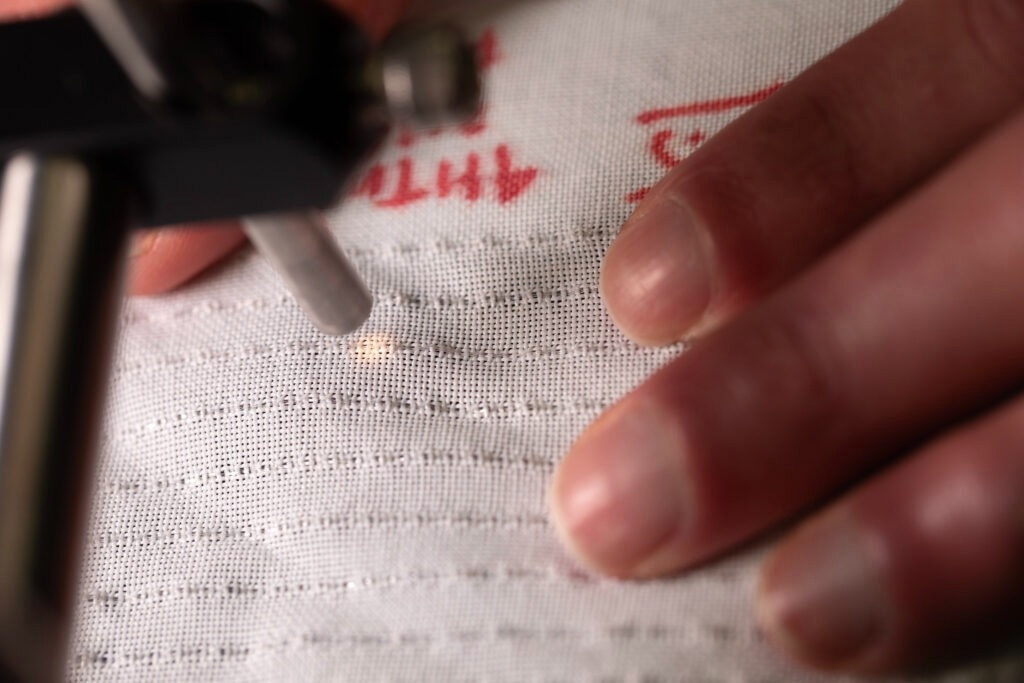Less than 15% of the 92 million tons of clothing and other textiles disposed of yearly are recycled, in part because they are so hard to sort. Woven-in labels made of low-cost photonic fibres created by a group led by the University of Michigan could change that.

Brian Iezzi scans and measures the photonic fibers in the fabric he developed. Image Credit: Marcin Szczepanski/Lead Multimedia Storyteller, University of Michigan College of Engineering
It’s like a barcode that’s woven directly into the fabric of a garment. We can customize the photonic properties of the fibers to make them visible to the naked eye, readable only under near-infrared light or any combination.
Max Shtein, Study Corresponding Author and Professor, Materials Science and Engineering, University of Michigan
The research was published in the journal Advanced Materials Technologies.
Ordinary tags are frequently trimmed or washed away until illegible, and tagless info can wear off. Recycling could be more efficient if a tag was intertwined and remained invisible until it was read. This is what the new fiber has the potential to do.
Near-infrared sorting systems are already used by recyclers to identify different materials based on their naturally occurring optical signatures—for example, the PET plastic in a water bottle looks completely different under near-infrared light than the HDPE plastic in a milk jug.
According to Brian Iezzi, a postdoctoral researcher in Shtein’s lab and lead author of the study, various fabrics have different optical signatures, but because of the predominance of blended fabrics, those signatures are of restricted use to recyclers.
For a truly circular recycling system to work, it’s important to know the precise composition of a fabric—a cotton recycler doesn’t want to pay for a garment that’s made of 70% polyester. Natural optical signatures can’t provide that level of precision, but our photonic fibers can.
Brian Iezzi, Study Lead Author and Postdoctoral Researcher, University of Michigan
The technology was created by combining Iezzi and Shtein’s photonic expertise (typically used in products such as displays, solar cells, and optical filters) with the sophisticated textile capabilities at MIT’s Lincoln Lab. The lab acted to integrate the photonic properties into a process that could be mass-produced on a large scale.
They completed the task by beginning with a preform, which is a plastic feedstock made up of dozens of alternating layers. They used acrylic and polycarbonate in this case. While each layer is clear, the mixture of two materials bends and refracts light to produce optical effects that resemble color. The same basic phenomenon causes butterfly wings to shimmer.
The preform is heated and then mechanically pulled into a hair-thin strand of fiber, much like taffy. While the manufacturing process differs from that of regular synthetic fibers such as polyester, it can produce the same miles-long strands of fiber. These strands can then be processed using the same machinery that textile manufacturers already use.
The investigators tuned the fiber to produce the right optical properties and ensure recyclability by adjusting the mix of materials and the speed at which the preform is pulled. While photonic fiber is more costly than conventional textiles, the researchers calculated that the cost of finished goods will only be slightly higher.
Iezzi says, “The photonic fibers only need to make up a small percentage—as little as 1% of a finished garment. That might increase the cost of the finished product by around 25 cents—similar to the cost of those use-and-care tags we’re all familiar with.”
According to Shtein, photonic labeling could be used to tell consumers how and where goods are made, as well as to confirm the authenticity of brand-name products, in addition to making recycling easier. It could be a way to provide significant value to customers.
As electronic devices like cell phones become more sophisticated, they could potentially have the ability to read this kind of photonic labeling. So I could imagine a future where woven-in labels are a useful feature for consumers as well as recyclers.
Max Shtein, Study Corresponding Author and Professor, Materials Science and Engineering, University of Michigan
The group has applied for patent protection and is considering options for commercializing the technology.
The National Science Foundation and the Under Secretary of Defense for Research and Engineering funded the study.
Journal Reference:
Iezzi, B., et al. (2023) Polymeric Photonic Crystal Fibers for Textile Tracing and Sorting. Advanced Materials Technologies. doi.org/10.1002/admt.202201099.
Source: https://umich.edu/